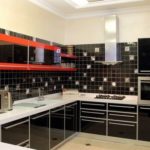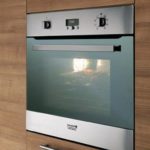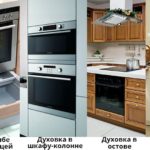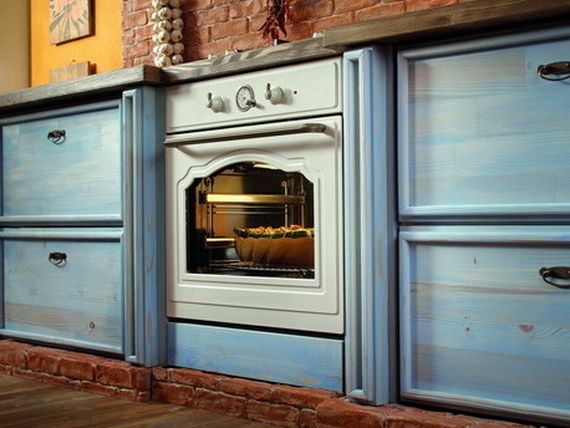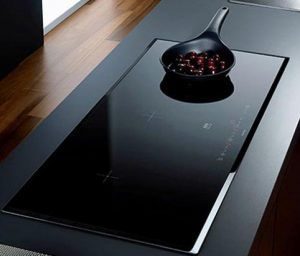How to choose an electric built-in oven
Stationary appliances are convenient and practical, but even in these parameters they are inferior to their built-in counterparts, which take up less valuable space in the kitchen. The stove-oven duo is a prime example of this: great functionality, ergonomics and a high level of safety... The list goes on and on. And if with a stove everything is more or less simple, then the price of ovens is influenced by so many factors that it can sometimes be very difficult to figure out what’s what.
The content of the article
How to choose an electric built-in oven - selection criteria
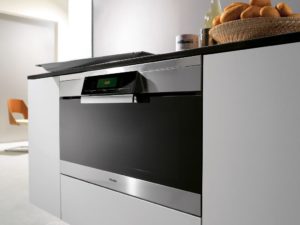 The first and most important question is gas or electricity. Gas ovens are relatively inexpensive and consume cheaper (for now) energy resources. This is where their advantages end and limitations begin: the number of options rarely exceeds 5, safety precautions, difficulties with connection and placement.
The first and most important question is gas or electricity. Gas ovens are relatively inexpensive and consume cheaper (for now) energy resources. This is where their advantages end and limitations begin: the number of options rarely exceeds 5, safety precautions, difficulties with connection and placement.
Electric built-in cabinets are more functional. Among the disadvantages, two main ones can be identified: such ovens are powered by expensive electricity and there are so many samples on the market that it can take days, if not weeks, to select the “ideal” option.You can save valuable time by reading the list of distinctive features and choosing the minimum required for yourself.
Dependent or independent
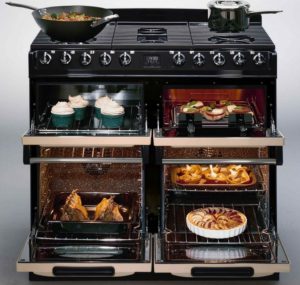 Dependent ovens are built in with the stove and have one common control panel. Among the advantages, one can highlight the financial side of the issue: the set will cost less than devices purchased separately. But there are more disadvantages:
Dependent ovens are built in with the stove and have one common control panel. Among the advantages, one can highlight the financial side of the issue: the set will cost less than devices purchased separately. But there are more disadvantages:
- if one thing fails, everything will have to be replaced;
- the control panel is overloaded;
- the oven is located under the stove, which reduces the ease of use;
- low size variability.
An independent oven can be placed at a convenient level. The model range is represented by a large number of options, from which it is easy to choose a version that is suitable in size and functionality. There is no connection to the type of power supply, because among the dependent options there is rarely the possibility of combining an electric stove with a gas oven or vice versa.
Dimensions, installation mechanism
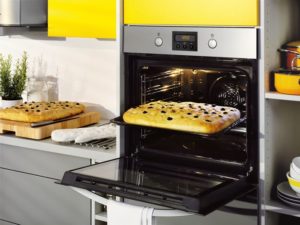 The classic size is 60x60 (height-width) with a depth of 55 cm. But there are compact or non-standard options when one of these parameters can be either larger or smaller. Here it’s worth focusing on “family needs.” For 2-3 people, a narrow oven is enough. But the larger the family and the more often there is baking on the table, the wider the oven should be.
The classic size is 60x60 (height-width) with a depth of 55 cm. But there are compact or non-standard options when one of these parameters can be either larger or smaller. Here it’s worth focusing on “family needs.” For 2-3 people, a narrow oven is enough. But the larger the family and the more often there is baking on the table, the wider the oven should be.
An important point regarding dimensions: if the dimensions of the selected option exactly match the dimensions of the niche for the device, the option is not suitable. The reason is simple - for safety reasons and to extend the service life of the oven, at least 0.5 cm should remain between its outer surface and the walls of the niche on the sides, about 8.5 at the bottom and 4 at the back.
Control system
It's simple here.There are electromechanical, electronic and combined control systems. The first option is three rotary controls responsible for heating mode, temperature and time. The switches can be recessed, which makes cleaning the oven surface easier, or non-recessed.
The electronic control system consists of a display and buttons or a sensor. The convenience and simplicity of electromechanics is countered by a larger number of functions and modes of operation of the device. But a combination of both options is also possible, which is represented by a hybrid, combined control system.
Functional
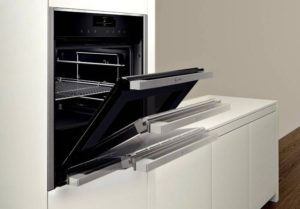 The usual heating modes - top, bottom and combi - can be combined with convection (when there is a built-in fan) and microwave (microwave). Thanks to this, a modern oven, in addition to baking, can also defrost, stew, simmer, maintain fermentation, or maintain a high temperature of the finished dish for a long time.
The usual heating modes - top, bottom and combi - can be combined with convection (when there is a built-in fan) and microwave (microwave). Thanks to this, a modern oven, in addition to baking, can also defrost, stew, simmer, maintain fermentation, or maintain a high temperature of the finished dish for a long time.
But that's not all. The oven can have a built-in steam generator, turning it almost into a full-fledged steamer, and a motor, which, using the included spit, takes the grill option to a new level. Some appliances even feature smart technology that allows you to control your oven using mobile apps.
The issue of ease of cleaning from contamination is also not overlooked. There are cabinets:
- traditional - coated on the inside with ordinary heat-resistant enamel, which will have to be washed in the usual way;
- with catalytic coating - special enamel softens greasy stains under the influence of high temperatures, which makes them easier to remove;
- with pyrothermic cleaning - when this mode is turned on, the oven heats up to 500 degrees and simply turns all dirt into dust (which can only be swept away with a sponge);
- with steam-water cleaning - steam softens dirt (the lack of a mode can be compensated for by simply turning on the oven for half an hour at a temperature of 60-70 degrees together with placing a baking tray with water poured into it).
It would probably be unnecessary to say that the cost of household appliances depends on the number of main and additional modes. But, nevertheless, it is recommended to choose models with functionality that will be “useful”, so as not to overpay for high-tech frills.
Door device
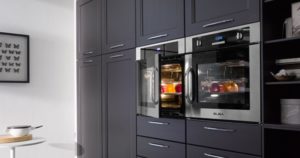 The classic is represented by a door that opens downwards. The stereotype is so ingrained into the subconscious that when they see hinged or retractable variations that open to the side, housewives lose their heads, forget about other parameters and opt for such models. Which is sometimes justified: with a fairly high placement of the oven, the door that opens to the side is more convenient, and with a low position, a pull-out door will also please you with a reduced risk of getting burned when taking the dish out of the cabinet.
The classic is represented by a door that opens downwards. The stereotype is so ingrained into the subconscious that when they see hinged or retractable variations that open to the side, housewives lose their heads, forget about other parameters and opt for such models. Which is sometimes justified: with a fairly high placement of the oven, the door that opens to the side is more convenient, and with a low position, a pull-out door will also please you with a reduced risk of getting burned when taking the dish out of the cabinet.
Energy consumption, power
There are ovens with power from 1 to 4 kW, of which:
- 2-3 kW are typical for standard models;
- 3.5 - 4 kW is the power of cabinets with a pyrothermic cleaning method;
- 1-1.5 kW - energy saving versions.
In terms of energy efficiency (the ratio of the speed of cooking and the amount of electricity consumed for this), ovens can belong to class A and B, but A+, A++ and even A+++ are more common. The more pluses, the smaller the numbers on the receipt.
Design and equipment
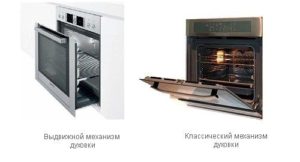 It's a pleasure to cook in a beautiful oven.It’s even better when it fits perfectly into the kitchen interior. Designers and manufacturers have come to a consensus on this issue and now you can purchase both modern appliances that match the color and type of front surface to the overall style of the kitchen, as well as retro-styled appliances.
It's a pleasure to cook in a beautiful oven.It’s even better when it fits perfectly into the kitchen interior. Designers and manufacturers have come to a consensus on this issue and now you can purchase both modern appliances that match the color and type of front surface to the overall style of the kitchen, as well as retro-styled appliances.
But, fortunately, this does not affect the internal “filling”. Ovens are still equipped with 2-3 baking trays and grill grates in the basic version. Additional equipment includes bread pans, telescopic guides, odor-catching filters, a temperature probe and a separator that allows you to cook previously incompatible dishes at the same time.
Security questions
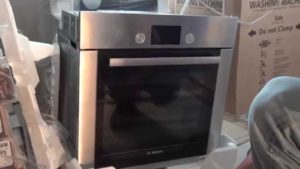 No matter how high-tech the built-in oven was, it would have to be abandoned due to the lack of a well-thought-out safety system.
No matter how high-tech the built-in oven was, it would have to be abandoned due to the lack of a well-thought-out safety system.
GOOD TO KNOW. For gas ovens, electric ignition and gas control are required to prevent the leakage of explosive substances. For electric ones - emergency shutdown when a certain (user-specified) temperature threshold is exceeded.
General measures taken by the manufacturer include:
- the number of glasses in a double-glazed window designed to protect against burns (varies from 2 to 4, the more, the colder the outer layer);
- possibility of locking the door and control panel;
- interior lighting (which some “forget” about);
- tangential cooling (external fan directing air flow around the oven).
When it comes to this point, it is not recommended to save money, because the greater the total number of bells and whistles, the safer the built-in oven.

